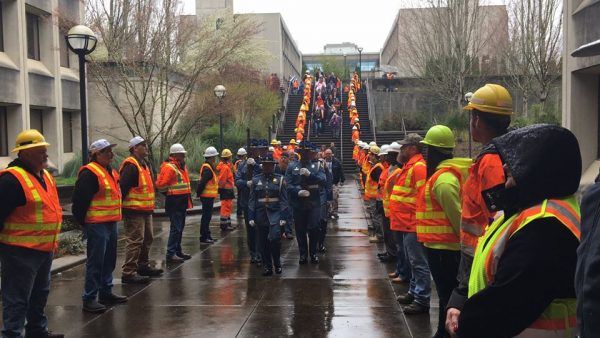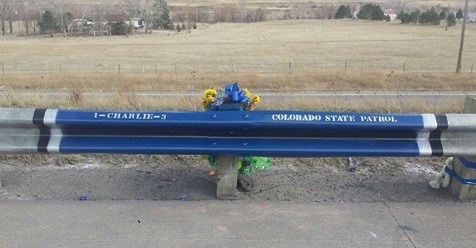Members of the Washington State Patrol commemorated roadway workers whose lives ended on highways and byways while keeping the flow of traffic free of snarl and danger. There is no argument against the perils of duty and danger to life as a transportation employee working the fast lane. Sadly, it often comes at a cost to themselves, and that is why the Move Over Law has been legislated throughout the United States, with the exception of D.C.
Not only are transportation employees, law enforcers, fire/rescue personnel, and paramedics subjected to inattentive motorists, so are tow truck operators heeding the call to safely remove automobiles from travel lanes and expressway shoulders.
Many makeshift grave markers exist along interstates, smaller highways, and less-traveled surface streets. Some of those commemorative roadside markers symbolize spots where a helper made a last stand on behalf of others. Yards from the interstate exit I use to get to/from my local area is fashioned with the neon orange-yellow traffic safety vest and gloves worn by a tow truck operator who, while boarding a car involved in a two-car wreck, was struck and killed by an inattentive, careless motorist who failed to move over.

Commemorating their civilian counterpart colleagues who also work the state’s public roadway, the Washington State Patrol Honor Guard recently paid tribute by leading family and loved ones of department of transportation utility workers through a procession of state employees. We all see them throughout the country: these brave hearts attend public thoroughfares where thousands of cars are motoring by within yards of pedestrians (state workers) ensuring flow. Some of these transportation department employees pay the ultimate price while safeguarding motorists from debris, infrastructure decay, hazardous materials’ spills and your dime-a-dozen car crashes.
I had the opportunity to visit the Tacoma/Seattle area a few years ago, and I was amazed at how much traffic breezes through on wet asphalt. I slow-crawled and sat in many traffic jams stemming from car crashes. I even witnessed a few wrecks, one of which resulted in a fatality. Late-night news reported details and footage which I physically observed while state patrol troopers closed the interstate.
All due respect to those who reside in the Seattle area, but traffic with which you contend seemed like a free-for-all way of life. Conversely, each of the myriad traffic crashes I saw was rather swiftly attended by emergency personnel and state DOT workers, all donning trademark neon-orange vests to mark their presence.
So what is it about bright orange or yellow vests and white or yellow hardhats drivers do not see?

Each of these lives lost due to motorists who chose to brush life too closely factored into the Move Over Law enactments across the nation not too many years ago.
Initially legislated for “emergency personnel” working on the roadways, the statute has since been expanded to include utility workers and wrecker drivers.
Struck performing public safety duties, it took too many dead cops before state legislatures drafted bills to implore drivers to move over and cite them when failing to do so. Yet, avoidable incidents (fatalities) involving those who earn their bread and butter working on thoroughfares persist. While investigating a traffic crash in I-25 in November 2016, Colorado state Trooper Cody Donahue was struck by a motorist who got too close. Trooper Donahue perished.

Recently, many states began modifying (strengthening) their respective Move Over Law. For instance, Oregon revamped its Move Over statute so that drivers are urged to change lanes for any vehicles “in distress” and, if moving over is not a viable (safe) option, the law states motorists must proceed at least 5 miles under the posted speed limit. Previously, motorists were legally obligated to only vacate the lane to allow emergency vehicles/first responders to work.
Yet some Oregonians argue that the changes to the law make matters worse, citing many drivers barely slow down instead of changing lanes. Five miles less is not going to make much difference, especially if motoring on an interstate. For comparison, Florida’s Move Over Law mandates changing lanes or, if unable to do so, driving 20 miles under the posted limit.
The danger is still present in either case. As any cop will readily share, vacating the lane is nevertheless the best course. And for those that are somehow last-minute observers, timing is relatively afforded by the sight of red/blue lights up ahead (especially at night).
Members of the Portland Police Bureau want drivers to change lanes and slow down. No contest from me.
For the most part along my travels, I witness a majority of drivers switching lanes—and actually using signals to do so—when an emergency vehicle or amber-lighted car or truck is in a lane or on the shoulder of Florida’s roadways, so the Mover Over Law seems to have largely sunk in. When it was first enacted in Florida, most auto operators I stopped claimed they never heard of it, even though Florida DOT did an expansive campaign to avail the statute via PSAs and other media blasts. Plus, and “educational campaign” ran for one month. Anyone stopped for a Move Over Law infraction was issued a mere warning (chat).
The irony in stopping motorists in violation of the Move Over Law was materialized in drivers pleading ignorance of this particular law while cars were flying by, many quite close to my bumper (and I’m not only talking about my cruiser). “What about that guy?” and “What about her car?” were typical roadside debates. It was a mobile mess— utterly death defying—yet it exemplified why Move Over laws were so direly needed.
Ultimately, our cops relied on PSAs and media coverage to get the point across. Frankly, we never had enough resources to effectively carry-out traffic operations. One police officer on a traffic stop with another cruiser behind watching for Move Over Law infractions was most sidelined as calls-for-service required response. End of operations.
But, as mentioned, the motoring public has gotten more observant, more cognizant, and more responsive to driver safety while out and about on public asphalt. To a cop, that is a godsend.
However, as we opened this discussion, we mourn the many who during the course of dangerous duty on the roads did not make it home. It circles back to the annual memorialization by law enforcement officers and DOT field personnel embracing their fortune of physically honoring the fallen…killed by those who didn’t quite share space well and/or let off the throttle.
Like many things in life, personal responsibility goes a long way.
















